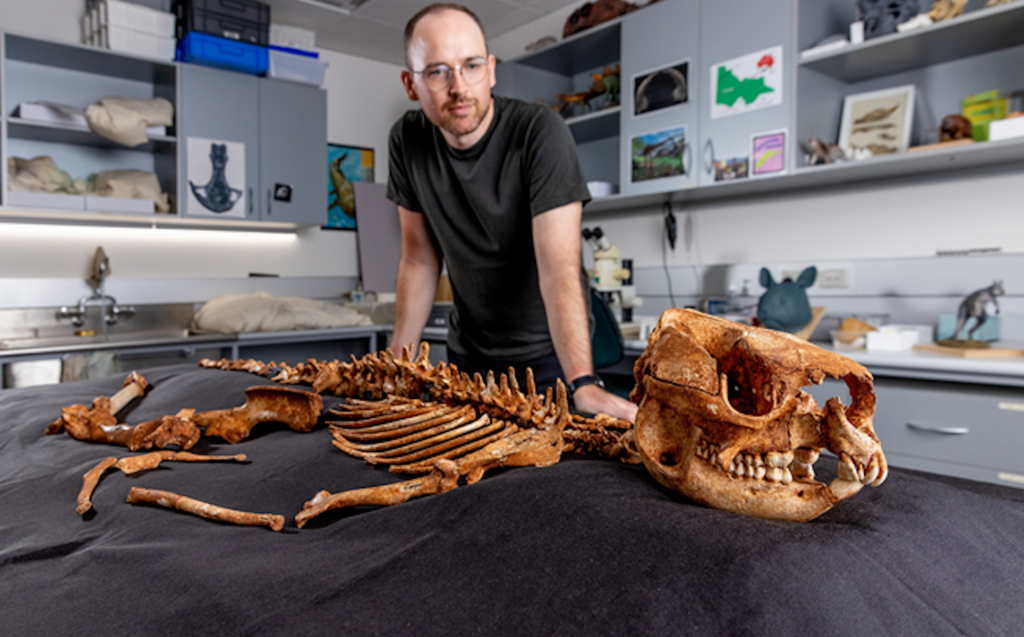Museums Victoria Research Institute has led a team of scientists, rangers, and citizen cavers to retrieve a near-complete skeleton of the extinct, short-faced kangaroo Simosthenurus occidentalis from deep within Nightshade Cave on Gunaikurnai Country near Buchan, East Gippsland.
This extraordinary 50,000-year-old discovery is one of the most complete fossils ever found in Australia. At 71% complete with 150 bones and a near-complete skull, it is the most complete fossil skeleton ever discovered in a Victorian cave, and it will be on public display at Melbourne Museum ahead of the winter school holidays.
The fossil was collected by a team who spent 58 hours underground to retrieve it safely. Museums Victoria Research Institute palaeontologist Tim Ziegler, who headed the research team, shared his excitement about the discovery. ‘Fossils of this quality and completeness are extremely rare in Australia. This skeleton has lain in a pitch-black cave for 50,000 years, and it’s been a privilege to bring it back to the light,’ he said.
The fossil was first sighted in 2011 by Buchan local Joshua Van Dyk, during the initial explorations of the cave. On a return visit over a decade later, Ziegler saw that its condition had begun to degrade, and began work to safely retrieve and conserve it.
Recreational cavers from the Victorian Speleological Association and rangers from Parks Victoria played a crucial role in the fossil excavation process, which was carried out over two years. The team worked tirelessly to ensure the safe retrieval of the skeleton, abseiling more than 20 metres underground and squeezing through tight passages encrusted by delicate stalactite crystals.
Parks Victoria Senior Ranger Phil McGuinn expressed his gratitude to everyone involved, saying, ‘This fossil skeleton was first seen and reported by members of the Buchan community. They’ve made an invaluable contribution to the natural heritage of the Buchan Caves, to the local area and to scientific knowledge worldwide.’ The precise location of Nightshade Cave on Potholes Cave Reserve, Murrindal, has not been publicly released.
The specimen, which is cared for by the Museums Victoria Research Institute at Melbourne Museum, Australia, has been made available for research projects of significant global interest. ‘Unlike its living cousins, Simosthenurus occidentalis was more comfortable walking with a striding gait, similar to that of humans or Tyrannosaurus rex: it did not hop,’ Ziegler explains. ‘This near-complete and exceptionally preserved specimen is helping scientists revolutionise our understanding of the deep past of Australia’s iconic fauna.’
Lynley Crosswell, CEO of Museums Victoria, praised the collaborative efforts of the research team. ‘We are committed to bringing ground-breaking research to communities across Victoria and around the world, and the collaborative recovery of this extraordinary fossil by the Museums Victoria Research Institute team and our partners is an event of global significance. By caring for this fossil in the State Collection, we will drive inquiry into our region’s unique natural heritage.’
Museums Victoria welcomes donors to help conduct world-class research. Supporters of the Museums Victoria Research Institute will contribute to expanding capacity within the wider community to generate biodiversity knowledge, collaborate on solutions for ecological conservation, and help enrich global scientific knowledge.
The Simosthenurus occidentalis fossil will be on public display in the Research Institute Gallery at Melbourne Museum from 24 June ahead of the winter school holidays, granting visitors rare access to the near-complete skeleton.
Visitors to Melbourne Museum are invited to learn more about Australia’s megafauna in Gandel Gondwana Garden and 600 Million Years: Victoria Evolveswhich features well-preserved fossil skulls of marsupial megafauna Palorchestes azael and Procoptodon gilli collected from Buchan.

